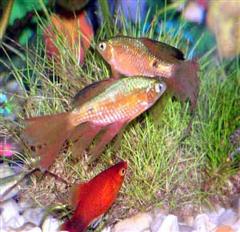Barb - Rosey
Scientific Name: Barbus conchonius
Sat, 19th July, 2025 - 3:07 am GMT
Sponsor Ads:

Alternative Name
Scientific Name: Barbus conchoniusBasic Info
The Rosy Barb gets its name from the exquisite shades of purple they develop when breeding. Most of the time, the Rosy Barb is a boring yellowish-gray color, with dark stripes. When it comes time to breed, however, the fish turns to a rosy color. This color change will also happen when they are excited. This color-changing trait makes the Rosy Barb quite interesting. At maturity, Rosy Barbs will reach a maximum size of two to three inches. Males are easily distinguished from females by their larger size and brighter colors. Male Rosy Barbs also have dark-tipped ventral fins. The females have clear ventral fins.
Health
Rosy Barbs, like other Barbs, are relatively easy to care for. Rosy Barbs should be kept in slightly acid and soft water, with the pH from 6.3 to 7.3, and with a colder temperature from 65 to 74 degrees fahrenheit. The can be fed flake foods, but prefer freeze-dried foods. Also, they should be given live food from time to time, including, blood worms, glass worms, plankton and brine shrimp. Breeding Black Ruby Barbs are relatively easy to breed. As mentioned before, this species changes colors when it is breeding. For optimum breeding, several males should be placed with one female and live food should be fed to the fish. Also, the temperature of the water should be raised a few degrees. They will spawn several times a year. After laying the eggs, the parents should be removed, as they will eat the eggs. The young should be fed microworms.Habitat
Fresh water fish- -found schooling in shallow, slow moving streams and rivers in South AsiaBehavior
The Rosy Barb is much like the Black Ruby Barb. It changes colors, depending on its state. Their large, reflective scales glitter in light, making them a stunning species to add to any aquarium. Rosy Barbs are also hardy and easy to care for, making them a good fish for the beginning aquarist. Rosy Barbs, like other Barbs, are little nippers. Their favorite pastime is to nip at other fish. However, if kept in schools of five or more, and in active tanks, the nipping shouldn't be too much of a problem. If Rosy Barbs are kept with slower fish, such as Angel Fish, the slower fish will shortly have damaged fins. Their behavior can be described not as aggressive, but as playful. The constant activity of the species makes it fun to watch. Rosy Barbs should be kept in brightly lit tanks, with lots of plants and a moderate amount of rocks.Origin
IndiaHistory
Rosy Barbs, or Barbus conchonius, are found schooling in shallow, slow moving streams and rivers in South Asia, specifically northern parts of India.Common Foods
N/ASponsor Ads:
Huh? Windows was designed to keep the idiots away from Unix so we could hack in peace. Let's not break that. -- Tom Christiansen
Barb - Rosey
Coded by: BGID® | ALL RIGHTS RESERVED Copyright © 2000-2025
Disclaimer | Privacy | Report Errors / Contact | Credits










